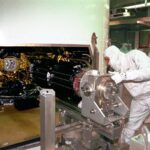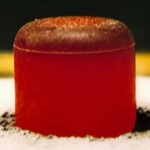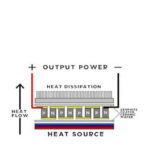Power-generation and heating units using radioactive decay as their primary energy source have been successfully used in space and on Earth for over 60 years.
This part looks at the principles and implementation of radioisotope-based heat and power.
Q: What has been the solution to this challenge?
A: It’s the elegant merging of two basic physics principles: the heat produced by radioactive decay and the Seebeck (thermocouple) effect. The result is a long-life, extremely reliable power source with no moving parts and functions despite the cold, and actually functions better as the ambient temperature gets colder. These units are called Radioisotope Power Systems (RPS) and serve in two roles: the Radioisotope Thermoelectric Generator (RTG) (Figure 1) and the Radioisotope Heater Unit (RTU). They have no moving parts, and mechanically rugged, and operate at full capability under a wide range of operating conditions.

Q: Are these units widely used?
A: Absolutely, and in various forms and sizes, they have served on nearly all manned and unmanned space missions and satellites since 1961, even if adequate solar power is available. In reality, you need some “ready to go” power source in addition to solar.
Q: What changes have been made in RTG design and operation?
A: There have been changes, of course, but given the very cautious nature of spacecraft designs and the risks associated with “upgrades,” but not many (Figure 2).

Q: What’s the history of RTGs and RTUs?
A: There are some notable milestones in their timeline:
The RTG was invented in 1954 by Mound Laboratories scientists Kenneth (Ken) C. Jordan (1921-2008) and John Birden (1918-2011). They worked on an Army Signal Corps to research radioactive materials and thermocouples suitable for directly converting heat to electrical energy using polonium-210 as the heat source. Subsequent research investigated the use of other radioactive materials.
- In 1961, the U.S. Navy’s Transit 4A navigation satellite became the first U.S. spacecraft powered by an RTG, developed by the Atomic Energy Commission, the predecessor to the Energy Department (Figure 3). Its RTG with 96 grams of plutonium-238 produced 2.7 watts.

- The Apollo missions to the moon included scientific-instrument packages that were left on the moon. The first package was solar-powered but relied on two 15-watt RHUs (higher power than subsequent “distributed” ones, discussed later) to keep its instruments warm enough to function. Subsequent packages were each powered by 70-watt SNAP-27 RTGs.
- In 1989, Galileo became the first spacecraft to orbit Jupiter. The Galileo orbiter was powered by two RTGs and included 120 RHUs to ensure its scientific instruments functioned properly.
- Pioneer 10 and Pioneer 11, launched in the early 1970s, were precursors to the interplanetary Voyager missions that followed. Each spacecraft was powered by four RTGs and kept warm by 12 RHUs.
- Each Voyager 1 and 2 uses nine RHUs to stay warm and draws power from three multi-hundred-watt radioisotope thermoelectric generators, which are still operating today at about one-third of their initial power levels.
- The two 42.6-watt RTGs on Viking 1 and 2 Mars missions (each was a lander and an orbiter) were designed to last at least 90 days but lasted for six and four years, respectively.
Q: RTGs and RTUs for space-related applications seem to get the most attention, but is this their only role?
A: No, not at all. Hundreds have been deployed by the U.S. and Russia (Soviet Union) at remote monitoring stations and even undersea locations.
The next part looks at RTG operation in more detail.
Related E.E. World Content
Thermal electric generators, Part 1: Principles and Implementation
Thermal Electric Generators, Part 2: Applications
Gravity-assist “Slingshot,” Part 1: Background and principle
Gravity-assist “Slingshot,” Part 2: Application
Making sense of thermocouples and interfaces (Part 1)
External References (with some comments)
NASA, JPL, Dept. of Energy
- NASA/JPL, “Radioisotope power systems reference book for mission designers and planners” (Detailed, fact-packed 91-page book!)
- NASA/JPL. “A Look at the Next Generation of Radioisotope Thermoelectric Generators” (15 slides, excellent)
- NASA, “Cassini Radioisotope Thermoelectric Generators (RTGs)”
- NASA, “After 60 Years, Nuclear Power for Spaceflight is Still Tried and True”
- NASA, “RHU Pull-Apart Animation”
- NASA, “FAQ About RPS” (very useful)
- NASA, “A Step Forward in Reestablishing the Radioisotope Power Systems Supply Chain” (plutonium production issues)
- NASA, “Power Systems” (summary with video of RTGs)
- NASA, “Thermal Systems” (summary with video of RTUs)
- NASA, “NASA’s RHU-Heated and RTG-Powered Spacecraft” (broad overview)
- NASA, “So What’s an RTG and Are They Safe?
- NASA, “General Purpose Heat Source – Light-Weight Radioisotope Heater Unit”
- NASA, “RHU Fact Sheet”
- S. Department of Energy, “What is a Radioisotope Power System?”
- S. Department of Energy, “The History of Nuclear Power in Space”
- S. Department of Energy, “Overview of Light Weight Radioisotope Heater Unit (LWRHU) User’s Guide”
Other sources
- American Nuclear Society, Science and Technology Policy Institute,” Current Status and Future of Space Nuclear Power” (provides various technical and policy perspectives)
- Stanford University, “An Overview of Radioisotope Thermoelectric Generators”
- Wikipedia, “Radioisotope heater unit”
- Wikipedia, “Radioisotope thermoelectric generator”
Earth’s heat and radioactivity
- University of Notre Dame Nuclear Science Laboratory “Radioactivity, Lecture 11: The radioactive Earth”
- Physics World, “Radioactive decay accounts for half of Earth’s heat”
- Scientific American, “Do transuranic elements such as plutonium ever occur naturally?”
- Lawrence Berkeley National Laboratory “What Keeps the Earth Cooking?”








Leave a Reply